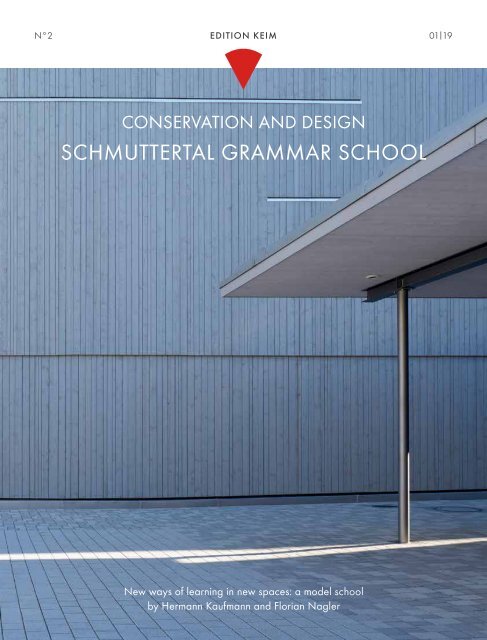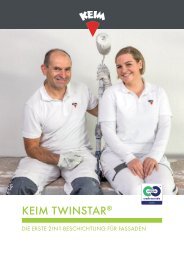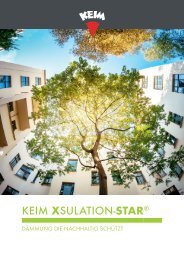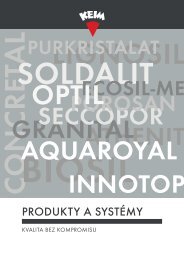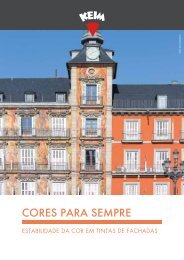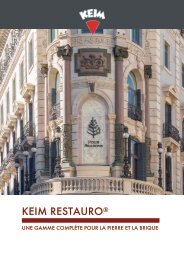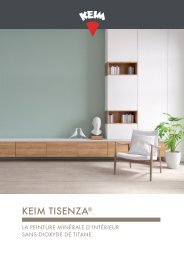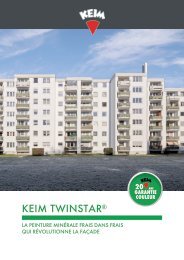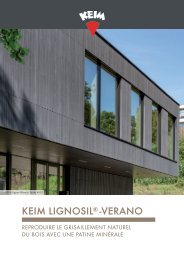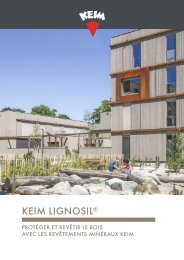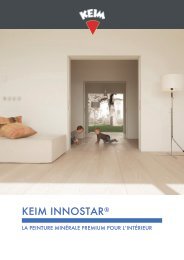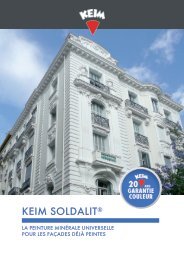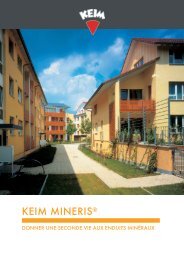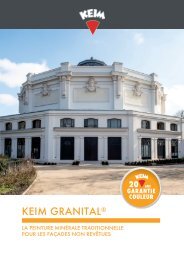KEIM Edition No. 2: Schmuttertal Grammar School
Create successful ePaper yourself
Turn your PDF publications into a flip-book with our unique Google optimized e-Paper software.
N°2 EDITION <strong>KEIM</strong><br />
01|19<br />
CONSERVATION AND DESIGN<br />
SCHMUTTERTAL GRAMMAR SCHOOL<br />
New ways of learning in new spaces: a model school<br />
by Hermann Kaufmann and Florian Nagler<br />
1
“A CHILD HAS THREE TEACHERS: THE FIRST TEACHER CONSISTS<br />
OF THE OTHER CHILDREN. THE SECOND TEACHER IS THE TEACHER.<br />
THE THIRD TEACHER IS THE SPACE.”<br />
SWEDISH PROVERB
EDITION <strong>KEIM</strong> N°2<br />
PRAISE FROM THE VERY TOP<br />
On 26 June 2017, <strong>Schmuttertal</strong> <strong>Grammar</strong> <strong>School</strong> received the German Prize for Architecture.<br />
This prize is deemed to be the most prestigious of all awards given to completed buildings in<br />
Germany. After all, it is awarded from the highest authority: from the Federal Ministry of Building<br />
BUMB in conjunction with the Federal Chamber of German Architects. Every two years, a jury<br />
comes together and selects outstanding building culture achievements.<br />
In fact, the group of buildings that make up <strong>Schmuttertal</strong> <strong>Grammar</strong> <strong>School</strong> act as a role model in<br />
many respects. The rooms comply with the latest educational requirements, the structure is made<br />
of the renewable raw material wood, the whole complex has a positive energy footprint and the<br />
design reveals high aspirations. The planners of this new building found relevant solutions for the<br />
task involved in constructing schools, which must be one of the biggest challenges of the future.<br />
3
GAINING<br />
BY<br />
FORGOING<br />
AN INTRODUCTION<br />
Significant steps in the construction of <strong>Schmuttertal</strong> <strong>Grammar</strong><br />
<strong>School</strong> were taken already before work on planning the<br />
building began. The aim was to create generous learning<br />
environments despite the limited space available, and to make<br />
it easier for children and teachers to identify with “their” school.<br />
4
5
SCHMUTTERTAL GRAMMAR SCHOOL<br />
It all began on a small scale. The grammar school in Diedorf began life in 2010 as a branch of<br />
a school in the neighbouring town of Gersthofen. Initially it was housed in containers with a staff<br />
of only around 15 teachers.<br />
Twelve months later, the rural district gave the go-ahead for a new-build. As part of a research<br />
project by the German Federal Environmental Foundation, the intention was to create suitable<br />
space to offer state-of-the-art education for about 800 children and youngsters. During a workshop<br />
in autumn 2011, teachers, parent representatives and pupils pooled their thoughts about<br />
their future school. They came up with some principle wishes, including having enough space<br />
for different teaching methods such as lecture-format and working in small groups, as well as<br />
stipulating some quite practical requirements, such as having enough shelf space for the satchels,<br />
given the frequent need to move the desks around during lessons to change the teaching<br />
methods. Chaired by Karin Dobener and her firm “LernLandSchaft”, the wishes were translated<br />
into functionalities and incorporated in a space program used by the architects as the basis for<br />
their design.<br />
At heart, the concept consists of learning environments, open areas where the classrooms in a<br />
year group are arranged around a “marketplace” measuring 100 m² in size. The teacher begins<br />
the lesson in the classroom with a short introduction, and then gives the pupils a task to solve<br />
unassisted in teams. They can move around freely in their learning environment and use various<br />
resources such as books and computers. Later on they all come together again to discuss their<br />
results with the teacher.<br />
The building has altogether seven of these “marketplaces”. How can such generous spacing<br />
be implemented in the framework of state school construction guidelines with their precise space<br />
allocations? By saving space elsewhere. For example, normally a school of 800 pupils will be<br />
granted three computer rooms measuring 70 m² each. But in this case, computer stations are<br />
integrated in the learning environments so that separate rooms are not needed. But the main<br />
thing is that the four classes in a year group share just three classrooms. After all, when the<br />
pupils are having sport, art, music, chemistry, biology or physics in a special room, one of the<br />
classrooms is usually empty. Making more efficient use of the space available gave the school<br />
the scope to implement its generous learning environments.<br />
The fact that the teachers were involved in devising this concept right from the start certainly<br />
made it easier for them to identify with their school. The same applies to the children and<br />
youngsters: while the building was under construction, the teachers and pupil representatives<br />
visited the wood construction company that produced the elements for the new building.<br />
This has apparently also helped the pupils to identify with the building: even three years after the<br />
grammar school opened, it is striking to see how few signs of wear-and-tear or vandalism there<br />
are. Headmaster Günter Manhardt puts it like this: “The pupils really appreciate what we’ve built<br />
for them here and they treat it carefully”.<br />
6
INTRODUCTION<br />
In the centre of the building invite open spaces for independent studying.<br />
7
8
9
10
BARNS<br />
IN A GREEN<br />
MEADOW<br />
ARCHITECTURE AND SPACE<br />
A grammar school with modern open-plan learning<br />
environments, made of wood, according to the energy-plus<br />
standard: those were the stipulations for the new-build<br />
<strong>Schmuttertal</strong> <strong>Grammar</strong> <strong>School</strong>. Hermann Kaufmann and<br />
Florian Nagler managed to give the whole thing a<br />
manifestly appropriate design.<br />
11
SCHMUTTERTAL GRAMMAR SCHOOL<br />
The school can already be seen from the station. Anyone who leaves the train in the small town<br />
of Diedorf near Augsburg and looks to the north west will notice four building structures positioned<br />
in the open countryside. With their gently sloping gable roofs and the grey board facades,<br />
it would be easy to think they were barns – which is exactly what the architects wanted. The<br />
grammar school is located at the edge of a landscape conservation area, and should blend as<br />
naturally and inconspicuously as possible in its rural setting.<br />
This is why the rooms for the school are shared out between four smaller buildings, rather than all<br />
being grouped in one larger structure. The three-pitch sports hall and the entrance building with<br />
the school hall, canteen, library, offices and music room act as a noise barrier to the railway line.<br />
These two buildings stand in front of the two classroom complexes, which are thus facing away<br />
from the railway line. The buildings are grouped around the school yard that forms the heart of<br />
the premises. Here the pupils are protected from the wind and can enjoy their breaks outside.<br />
The facades already indicate that the buildings are made of wood. A curtain wall of vertical<br />
spruce boards envelops the structures. While appearing to be plain from a distance, a closer view<br />
shows a more varied structure with the boards of differing widths arranged in a “wild pattern”.<br />
The facade protrudes by about 15 centimetres with each additional storey – an old wood<br />
construction principle where the upper storey protects the windows of the storey below. Here the<br />
concept was used to ensure that the cassettes for the window blinds are concealed unobtrusively<br />
behind the boards. The shadows created in this way give the building a lively, vivid appearance.<br />
The buildings frame a central schoolyard, glazed walkways provide wind protection.<br />
12
ARCHITECTURE AND SPACE<br />
View from the open music hall through the auditorium to the main entrance: strikingly slender columns support the roof.<br />
Wood also plays a main role inside the buildings. Consistent use of the renewable construction<br />
material makes a major contribution to minimising the school’s ecological footprint. Left visible in<br />
its natural state, the material defines the rooms. The functional structure is immediately visible right<br />
behind the main entrance in the generous two-storey vestibule: pillars, beams and rafters carry<br />
the load, while wall panels shape the space. The wood surfaces all have a white glaze. This<br />
prevents any mountain-chalet atmosphere and stops the wood from darkening with age, which<br />
would make the rooms seem gloomier after a few years.<br />
13
14
ARCHITECTURE AND SPACE<br />
A large glass door opens into the two-storey school hall. The two rows of columns on the right<br />
and left, the symmetrical gable roof and the light penetrating from the “side aisles” create the<br />
impression of a basilica, radiating a certain dignity and peace. Those who are so inclined can<br />
even let the closely spaced wooden supports remind them of a forest. But the planning team‘s<br />
declared intention with the close spacing was to minimise the pillar cross-section, resulting in very<br />
slender, elegant proportions.<br />
A short glazed walkway leads to the two classroom buildings, where the layout is organised in<br />
layers. The ground floor has the art and science rooms positioned at the facade, while the dark<br />
zone in the middle of the building is used for ancillary rooms to store collections of materials, for<br />
example. The learning environments are located in the two upper storeys. The classrooms in a<br />
year group are arranged in each case around a generous “marketplace” instead of the traditional<br />
corridors. These areas are furnished with sofas, computers, pinboards and much more besides<br />
to encourage independent learning. Each storey has two such learning environments. The classrooms<br />
are arranged along the north and south facade with the marketplace in the middle of the<br />
building, where daylight shines down from above through voids that let it penetrate deep into<br />
the building. The storey is rounded off by a shared cloakroom, a small staffroom and sanitary<br />
facilities. Each year group has its own toilets to encourage the pupils to treat the facilities with<br />
due care.<br />
A spacious wall acts as the transition between classroom and “marketplace”, accommodating<br />
not just shelves, cupboards and washbasins but also the extensive building systems needed to<br />
keep the building supplied with fresh air. The doors are usually open when the pupils work on<br />
their own or in small groups, spreading out throughout the rooms; large glass panels give a clear<br />
view and make supervision easier for the teacher. The installations follow the rhythm set by the<br />
support structure, resulting altogether in an artistic entity made of wood.<br />
There’s no point in looking for the traditional school desks for two children each. Instead, small,<br />
lightweight single tables on casters make it quick and easy to rearrange the furniture, depending<br />
on what specific approach the teacher is taking. After all, the concept aims to make it possible<br />
for the learning methods to be changed repeatedly during the lesson. At long last, Diedorf now<br />
has enough space for this approach.<br />
When walking through the rooms, one striking aspect is the good air: it’s not dusty or stuffy, there’s<br />
not a hint of floor polish or other smells. This is due not just to the ventilation system that diligently<br />
does its job but also to the special effort that went into selecting the construction materials. All<br />
materials had to comply with the strictest biological requirements, with more than 500 products<br />
being carefully examined before they were used. Indeed, the whole project was geared to a<br />
high ecological standard. The well insulated buildings are so economical that the photovoltaic<br />
array on the roofs generates more primary energy than the whole school needs. That makes<br />
<strong>Schmuttertal</strong> <strong>Grammar</strong> <strong>School</strong> an energy-plus school – by the way, one of the first in Germany.<br />
15
SCHMUTTERTAL GRAMMAR SCHOOL<br />
1<br />
2<br />
4<br />
3<br />
ZT GmbH<br />
kten GmbH<br />
1 Classroom 81245 München with open-plan learning environments<br />
Projektnummer Archiv<br />
Planinhalt<br />
2 Classroom with open-plan learning environments<br />
11_38<br />
M 1:750 1. OBERGESCHO<br />
3 Administration wing with auditorium<br />
4 Gym<br />
Theodor-Storm-Str.16<br />
Fon 089 / 820 051 - 0<br />
Fax 089 / 839 287 - 43<br />
diedorf@nagler-architekten.de<br />
diedorf@hermann-kaufmann.at<br />
Publikationsplan<br />
Plannummer CAD Projekt<br />
2_veröffentlichungen hk IV 825<br />
GYMNASIUM DIEDO<br />
On leaving the school, the impression remains that this is an exemplary achievement. Instead of<br />
superficial, sensationalist, spectacular architecture, the convincing buildings stand out with unobtrusive,<br />
quiet solutions that have nevertheless been thought through right down to the very last<br />
detail. Detailed records were kept of the pilot project sponsored by the DBU (German Federal<br />
Environmental Foundation) and all the experience gained with the project has been put in the<br />
public domain to make it accessible for every planner. And so there are good chances that the<br />
grammar school in Diedorf may be replicated elsewhere.<br />
16
PROJECT INFORMATION<br />
PROJECT PARTICIPANTS<br />
Client<br />
Educational concept<br />
Architecture<br />
Project management<br />
Cost planning<br />
Structural engineering<br />
HVAC planning<br />
Fire safety planning<br />
Energy concept<br />
Structural and room<br />
acoustics, thermal<br />
construction physics<br />
Electrical planning<br />
Light planning<br />
Hazardous materials,<br />
eco-footprint and<br />
lifecycle costs<br />
Landscape planning<br />
Project support and<br />
coordination<br />
Safety und security<br />
coordination<br />
Wooden construction<br />
companies<br />
Monitoring and quality<br />
assurance<br />
Augsburg District, represented by<br />
District Administrator Martin Sailer<br />
LernLandSchaft, Röckingen<br />
Mariagrazia Lanza, Maha Kutay<br />
“Diedorf” consortium:<br />
Hermann Kaufmann + Partner<br />
ZT GmbH, Schwarzach<br />
Florian Nagler Architekten<br />
GmbH, München<br />
Department for Structural<br />
Engineering Augsburg District,<br />
represented by Senior Director of<br />
Construction Frank Schwindling<br />
Architect Roland Wehinger<br />
merz kley partner GmbH,<br />
Dornbirn<br />
Wimmer Ingenieure GmbH,<br />
Neusäß<br />
Bauart Konstruktions<br />
GmbH & Co. KG, München<br />
ip5 Ingenieurpartnerschaft,<br />
Karlsruhe<br />
Müller-BBM GmbH, Planegg<br />
Consultant engineers<br />
Herbert Mayr, Rommelsried<br />
Lumen3 GbR, München<br />
Ascona GbR, Gröbenzell<br />
ver.de landschaftsarchitekten<br />
GbR, Freising<br />
kplan AG, Abensberg<br />
InterQuality Service AG,<br />
Augsburg<br />
Kaufmann Bausysteme, Reuthe<br />
ZÜBLIN Timber GmbH, Aichach<br />
ZAE Bayern, Garching<br />
FACTS AND FIGURES<br />
Location Schmetterlingsplatz 1<br />
86420 Diedorf<br />
Construction period 09/2013 – 09/2015<br />
Main effective space 7.816 m²<br />
Net floor space 14.048 m²<br />
Gross floor space 16.046 m²<br />
Gross building volume 81.390 m³<br />
Primary energy requirement<br />
without userinduced<br />
consumption<br />
Primary energy requirement<br />
incl. userinduced<br />
consumption<br />
Installed power<br />
PV array<br />
Facade glaze<br />
Glaze on inner<br />
wooden structures<br />
AWARDS<br />
39,7 kWh/m²a<br />
62,9 kWh/m²a<br />
440 kWp<br />
<strong>KEIM</strong> Lignosil-Verano<br />
in grey 4861<br />
<strong>KEIM</strong> Lignosil-Inco, white<br />
German Prize for Architecture 2017 (1st prize)<br />
DGNB Prize for Sustainable Construction 2016<br />
(1st prize)<br />
German Prize for Wooden Construction 2017<br />
(prize for new-build)<br />
Iconic Awards 2018<br />
(Innovative Architecture Selection)<br />
Bavarian Energy Prize 2016<br />
(category: building as energy system)<br />
Geplant + Ausgeführt 2017, IHM trade fair prize<br />
(special prize: Focus Healthy Construction)<br />
Vorarlberg Prize for Wooden Construction 2017<br />
(recognition from outside the country)<br />
17
HERMANN KAUFMANN + FLORIAN NAGLER<br />
Hermann Kaufmann and Florian Nagler in a conversation.<br />
The client responsible for<br />
<strong>Schmuttertal</strong> <strong>Grammar</strong> <strong>School</strong><br />
benefited from input from two<br />
firms of architects with a focus<br />
on sustainability and modern<br />
wooden construction.<br />
Prof. Hermann Kaufmann and<br />
Prof. Florian Nagler discuss the<br />
planning process and their<br />
collaboration.<br />
How did the collaboration between your<br />
two firms come about?<br />
Hermann Kaufmann: <strong>Schmuttertal</strong> <strong>Grammar</strong><br />
<strong>School</strong> was to be Germany’s first school built<br />
as a wooden construction in the energy-plus<br />
standard. The project is sponsored by the<br />
German Federal Environmental Foundation<br />
(DBU). They approached my firm in their<br />
search for architects who could offer experience<br />
with wooden construction. In view of<br />
the project location in Germany, I invited my<br />
colleague Florian Nagler to reinforce the team.<br />
18
INTERVIEW<br />
We know each other as professors at TU<br />
Munich and share a similar mindset in many<br />
architectural issues.<br />
Was the design a joint development?<br />
Florian Nagler: Yes and no. Initially we<br />
each produced a rough concept of our<br />
own, and then we joined forces. The<br />
solution that has now been used emerged<br />
gradually from the subsequent discussions.<br />
What was the difference between your<br />
first concepts?<br />
Hermann Kaufmann: I put all the rooms<br />
together in one single compact building,<br />
while Florian Nagler shared them out between<br />
individual buildings that blended in<br />
harmoniously with the landscape. This was<br />
then the approach that we took.<br />
Florian Nagler: Originally we wanted to<br />
have six smaller buildings but the initial cost<br />
estimated showed this to be too expensive<br />
because of the large enveloping surface.<br />
We then changed the concept to four compact<br />
buildings with an extra storey each.<br />
Did you work together on all the planning,<br />
or did you share the tasks out?<br />
Florian Nagler: My team is better acquainted<br />
with German building law, so we produced<br />
the plans for the building application<br />
and dealt with construction phases 1 to 4.<br />
Hermann Kaufmann was responsible for<br />
detailed planning for phase 5, then my firm<br />
took on the tendering and construction supervision<br />
phases 6 to 9 because Munich is<br />
closer to Diedorf. Hermann Kaufmann took<br />
care of the costs throughout the planning<br />
process and wrote the research report that<br />
was published about the school building.<br />
Did this pilot project involve more<br />
planning than comparable projects?<br />
Florian Nagler: Much more. Wooden<br />
construction generally demands more complicated<br />
detailed planning than a plastered<br />
solid building, for example. But this wasn’t<br />
the issue as we had both already gained<br />
experience with wooden construction from<br />
earlier projects. The issue was that we were<br />
breaking new ground with this school in<br />
many respects.<br />
Hermann Kaufmann: The open-plan learning<br />
environments and visible wooden structures<br />
in a public building of this size demanded<br />
a particularly convoluted approach for integrating<br />
the building systems in the context<br />
of fire safety. The ambitious energy-plus<br />
concept also resulted in a far greater need<br />
for planning and consultation.<br />
Could you then say that the project<br />
was at all “worthwhile” for your firms?<br />
Hermann Kaufmann: Well, let’s put it this<br />
way: we are extremely pleased with the<br />
recognition and with the many awards that<br />
have come our way through the project.<br />
Hermann Kaufmann + Partner ZT GmbH<br />
www.hkarchitekten.at<br />
Florian Nagler Architekten GmbH<br />
www.nagler-architekten.de<br />
19
HERMANN KAUFMANN + FLORIAN NAGLER<br />
1 2<br />
BUILDING WITH WOOD<br />
HERMANN KAUFMANN<br />
FLORIAN NAGLER ARCHITEKTEN GMBH<br />
I. Conversion Tannerhof, Bayrischzell<br />
II. Residential Building Dantebad, München<br />
III. Foundation Nantesbuch, Karpfsee Estate<br />
IV. Entrance Glentleiten open-air museum<br />
V. Residential Building in Berg, Lake Starnberg<br />
II<br />
I<br />
III<br />
20
WOODEN ARCHITECTURE<br />
HERMANN KAUFMANN + PARTNER ZT GMBH<br />
1. Office bulding Montafon, Vandans<br />
2. Local history museum, Alberschwende<br />
3. Commercial building with workshop, Lauterach<br />
4. Nebelhorn summit station, Oberstdorf<br />
5. Residential building Kopf, Au<br />
3<br />
4 5<br />
+ FLORIAN NAGLER<br />
IV<br />
V<br />
21
22<br />
SCHMUTTERTAL-GYMNASIUM
PERFECT<br />
CLIMATE ALL<br />
YEAR ROUND<br />
CLIMATE, ECOLOGY AND ENERGY<br />
Ecological role model: <strong>Schmuttertal</strong> <strong>Grammar</strong> <strong>School</strong> is one of the<br />
first school buildings in Germany that generates more energy than it<br />
consumes, which means it has a carbon footprint of practically zero.<br />
A sophisticated energy concept ensures the rooms always feel<br />
comfortable with pleasant temperatures, even in the summer.<br />
23
SCHMUTTERTAL GRAMMAR SCHOOL<br />
A cool head in summer, warm feet in winter: The floor can cool and heat and increase comfort.<br />
Stuffy classrooms after doing a test, pupils and teachers groaning from the summer heat – not<br />
in this new school building! The planning process gave absolute priority to ensuring that there<br />
would always be a pleasant climate in the rooms without consuming too much energy. The concept<br />
is based on a well-insulated building envelope that keeps the heat out in the summer and<br />
the cold out in the winter. But it is above all the losses entailed when the rooms are aired that<br />
impacts on energy consumption in school buildings. The recommendations for school buildings<br />
stipulated that the densely packed classrooms must have three air changes per hour, which is<br />
six times more than in residential buildings with an air change rate of 0.5. The school therefore<br />
has mechanical ventilation with heat recovery to minimise energy losses.<br />
Sensors measure the CO 2<br />
level in the rooms so that there is always an inflow of fresh air whenever<br />
the need arises. This prevents any “stuffy air” which is detrimental to concentration. The windows<br />
can still be opened on request, but there is no longer a need to open the windows regularly with<br />
the resulting loss of heat in winter.<br />
24
CLIMATE, ECOLOGY, ENERGY<br />
Heating is scarcely needed at all, because 20 to 30 pupils in each classroom generate enough<br />
heat to maintain a pleasant temperature in a well-insulated room. A pellet boiler fired with renewable<br />
raw materials covers the remaining low energy demand. An underfloor heating system distributes<br />
the heat, which is only needed on particularly cold winter days.<br />
In summer on the other hand, the building has to be kept cool. The rooms therefore mainly point<br />
to the north or south so that they aren’t heated up unnecessarily by the low-lying sun in the east<br />
and west. South-facing windows are fitted with venetian blinds whose slats keep the sun out when<br />
it is standing high while still letting enough indirect daylight into the rooms to manage without<br />
artificial lighting. These passive measures already bring about a considerable reduction in the<br />
cooling requirements. If more is needed, the underfloor heating is changed over to an active<br />
cooling system: cold water flows through the pipes during the night and extracts heat from the<br />
room. The 10 cm cement screed acts as an accumulator that preserves the coolness of the night<br />
for the next day.<br />
Electricity is generated by a photovoltaic array on the roof. The annual energy yield exceeds the<br />
total primary energy needed for heating, cooling, ventilating and lighting the building. <strong>Schmuttertal</strong><br />
<strong>Grammar</strong> <strong>School</strong> therefore complies with the energy-plus standards, far surpassing most other<br />
school buildings.<br />
But the question is, will this annual energy surplus actually suffice to balance out the embodied<br />
energy that flowed into the actual construction of the building. After all, on the bottom line it is a<br />
case of how much harmful CO 2<br />
is saved throughout the entire life cycle of the building. The ecological<br />
footprint was based on a service life of 50 years. During this period, the building manages<br />
almost completely to “recover” the quantity of CO 2<br />
emitted during its construction, giving<br />
the school a carbon footprint of nearly zero.<br />
The carbon footprint of any building has to consider the climate impact of both the construction<br />
phase and the building’s subsequent use. A major role in the case of <strong>Schmuttertal</strong> <strong>Grammar</strong><br />
<strong>School</strong> is played by the very low impact that the wooden construction has on the climate, as<br />
seen in comparison with a conventional solid construction built according to the EnEV standard<br />
(German Energy-Saving Ordinance). Taken over a period of 50 years, the school in Diedorf<br />
managed to reduce the CO2 equivalent for construction and usage by around 95 percent.<br />
Climate potential 50 a in kg CO 2<br />
-equivalence<br />
Building operation<br />
Building construction<br />
60.000.000<br />
50.000.000<br />
40.000.000<br />
30.000.000<br />
20.000.000<br />
10.000.000<br />
0<br />
– 10.000.000<br />
Solid Construction<br />
in EnEV standard<br />
Timber<br />
construction as<br />
passive house<br />
<strong>Schmuttertal</strong><br />
<strong>Grammar</strong> <strong>School</strong><br />
25
SHHHHHH!<br />
ACOUSTICS<br />
The acoustics of school rooms has an influence on<br />
concentration and learning results. A new approach was<br />
also necessary for the building acoustics because the<br />
educational concept entailed less lecture-format lessons<br />
and more group work using all parts of the room.<br />
Soundproofing between the rooms is usually very important in schools. However, this made less<br />
sense in the learning environments for <strong>Schmuttertal</strong> <strong>Grammar</strong> <strong>School</strong> where the doors between<br />
the classrooms and the central “marketplace” usually stay open.<br />
Furthermore, the emergency exits between the classrooms also acted as an inevitable weakness<br />
in the acoustic concept. Attention therefore focused primarily on reducing the noise level in the<br />
rooms. Here the planners reverted to experience gained in Denmark and Sweden, two countries<br />
that already have several schools with open-plan learning environments.<br />
26
ACOUSTICS<br />
Ceilings and walls are optimised for decentralised teaching which entails a certain noise impact.<br />
The aim was to achieve a short echo time so that the spoken word would be intelligible across<br />
short and longer distances. To this end, the end walls are lined with sound-absorbing wood<br />
wool panels and spruce strips with narrow spacing. The original design for the ceiling featured<br />
suspended felt baffles to keep the structure free and to use the space as a thermal accumulator.<br />
However, the baffles would not have been capable of absorbing sound sufficiently in the lowfrequency<br />
range, so that it was decided to use a flat ceiling lining with wood wool. The floor is<br />
designed with a 10 cm cement screed to act as accumulator instead.<br />
Does the acoustic concept also work in practice? Measurements in the completed building have<br />
shown that all the values calculated in advance are indeed met on site. And what do the teachers<br />
say subjectively about the noise level? They are most satisfied: they don’t have to tell the pupils to<br />
quieten down nearly so often in the new rooms.<br />
27
ESCAPING<br />
FROM<br />
FIRE<br />
FIRE SAFETY<br />
Neither the school construction guidelines nor the state<br />
building codes contain any regulations about open-plan learning<br />
environments. The planners have therefore come up with special<br />
fire safety solutions that could also apply to other schools.<br />
28
quivalenz<br />
60.000.000<br />
FIRE SAFETY<br />
In the event of a fire, pupils and teachers have to be able to leave the building as quickly as<br />
possible. <strong>No</strong>rmally the escape route would take them out of the classroom along a necessary<br />
corridor to the necessary stairs. But this was not possible at <strong>Schmuttertal</strong> <strong>Grammar</strong> <strong>School</strong> due to<br />
the open-plan learning environments and all the furniture, which acts as a fire load. The planners<br />
had to prove that they had provided compensation for this deviation from the regulations. The most<br />
obvious solution with emergency exit balconies and fire escapes on the outside of the building<br />
was out of the question because this would have interfered with the barn-like appearance that<br />
the architects wanted to give the buildings. It would also have been a very costly solution.<br />
Instead, they took another approach: in the upper storeys, the first and second escape route from<br />
the classrooms goes along the corridor of the open-plan learning environment which just acts as<br />
a circulation route; at either end of the corridor the escape route leads to a necessary staircase<br />
which fulfils the requirements of the state building code. The crucial aspect is the third escape<br />
route to compensate for the corridor which is a problem in terms of fire safety: a connecting door<br />
between the classrooms lets pupils and teachers escape directly into a staircase, regardless of<br />
the open-plan learning environments.<br />
The fire safety concept naturally also includes fire alarms, automatic smoke extraction openings in<br />
the roof and much more besides. The combination of structural, technical and organisational fire<br />
safety achieved a level equivalent to that in conventional school buildings.<br />
First floor floor plan of a class tract<br />
29
30
THE WOODEN<br />
STRUCTURE<br />
IN DETAIL<br />
STRUCTURE AND<br />
CONSTRUCTION PROCESS<br />
It’s not every day that a grammar school for about<br />
800 pupils is built as a prefabricated wooden construction<br />
in Germany. Which support structure, which degree of<br />
prefabrication and which construction stages did the<br />
planners in Diedorf choose?<br />
31
c<br />
Plan-Nr.<br />
c<br />
Plan-Nr.<br />
c<br />
Plan-Nr.<br />
b<br />
b<br />
b<br />
a<br />
a<br />
a<br />
c<br />
Plan-Nr.<br />
c<br />
Plan-Nr.<br />
c<br />
Plan-Nr.<br />
b<br />
b<br />
b<br />
a<br />
a<br />
a<br />
SCHMUTTERTAL GRAMMAR SCHOOL<br />
Counting from the surface of the basement ceiling, nearly all structures of the <strong>Schmuttertal</strong> <strong>Grammar</strong><br />
<strong>School</strong> are constructed from spruce wood. The layout of the buildings is based on a grid of<br />
2.7 m. All rooms are designed accordingly, with the basic dimension being divided or multiplied<br />
as the need arises. The grid has more than 1,000 supports. They carry the joists which in turn support<br />
the ceilings, which consist of wood-concrete composite structures for soundproofing reasons.<br />
Lightweight ribs made of laminated wood with a cross section of 18x32 cm are laid at intervals<br />
of 90 cm to form the tensile zone. OSB boards are placed on top as lost formwork and covered<br />
by a 10 cm layer of heavy in-situ concrete as pressure zone. The interaction of wood and concrete<br />
results in coffered ceilings which span the rooms at a very low height with a centreto-centre<br />
distance of 8.1 m.<br />
The storey ceilings brace the skeleton construction, with the sloping roofs lined with three-layered<br />
Schritt 2: Deckenelemente über EG<br />
boards in certain places for the same purpose. In the vertical level, they are supported by individual<br />
timber-frame walls also lined with OSB. The other inner and outer walls do not have a<br />
structural function.<br />
Schritt 1: Wände + Stützen EG<br />
Gez. 04.10.13/wih<br />
81307<br />
Projekt-Nr.<br />
Massstab 1:200<br />
Gymnasium Diedorf<br />
Gez. 04.10.13/wih<br />
81307<br />
Projekt-Nr.<br />
Massstab 1:200<br />
Gymnasium Diedorf<br />
Schritt 3: Wände + Stützen 1. OG<br />
Index Änderung Datum gez.<br />
Gez. 04.10.13/wih<br />
Projekt-Nr. 81307<br />
Massstab 1:200<br />
Ausschreibungsplan<br />
Montageablauf Gymnasium Diedorf Schritt 1: Wände+Stützen<br />
Schritt 4: Deckenelemente über 1. OG<br />
Index Änderung Datum gez.<br />
Gez. 04.10.13/wih<br />
Projekt-Nr. 81307<br />
Massstab 1:200<br />
Ausschreibungsplan<br />
Montageablauf Gymnasium Diedorf Schritt 2: Deckenelemente<br />
Schritt 5: Wände + Stützen 2. OG<br />
Structure, space formation and assembly steps<br />
01<br />
MONTAGEKONZEPT<br />
08.11.2013 I GYMNASIUM DIEDORF<br />
MONTAGEKONZEPT<br />
08.11.2013 I GYMNASIUM DIEDORF<br />
Gez. 04.10.13/wih<br />
Index Änderung Datum gez.<br />
Änderung Datum gez.<br />
Index<br />
81307<br />
Projekt-Nr.<br />
Massstab 1:200<br />
03<br />
Ausschreibungsplan<br />
Gymnasium Montageablauf Diedorf Schritt 3: Wände+Stützen<br />
Schritt 6: Dachelemente<br />
05<br />
Ausschreibungsplan<br />
Montageablauf Schritt 5: Wände+Stützen<br />
02<br />
MONTAGEKONZEPT<br />
08.11.2013 I GYMNASIUM DIEDORF<br />
MONTAGEKONZEPT<br />
08.11.2013 I GYMNASIUM DIEDORF<br />
Gez. 04.10.13/wih<br />
Index Änderung Datum gez.<br />
Änderung Datum gez.<br />
Index<br />
81307<br />
Projekt-Nr.<br />
Massstab 1:200<br />
04<br />
06<br />
Ausschreibungsplan<br />
Gymnasium Montageablauf Diedorf Schritt 4: Deckenelemente<br />
Ausschreibungsplan<br />
Montageablauf Schritt 6: Dachelemente<br />
32<br />
MONTAGEKONZEPT<br />
08.11.2013 I GYMNASIUM DIEDORF<br />
MONTAGEKONZEPT<br />
08.11.2013 I GYMNASIUM DIEDORF
STRUCTURE AND CONSTRUCTION PROCESS<br />
Up to 12 m long, the prefabricated wall elements were delivered to the construction site.<br />
The declared aim of the client was to have a high degree of prefabrication. The structures were<br />
therefore designed with ideal dimensions for transport. The facade elements measuring 12 m in<br />
length for example were prefabricated in the factory including thermal insulation and windows<br />
and brought in vertical position to the building site, before being fitted with the prefabricated outer<br />
formwork on site. The entire wooden structure was going to be subsequently visible in the interior<br />
rooms, so that rain protection had to be provided as quickly as possible during the construction<br />
phase. The classroom buildings were therefore not assembled storey by storey but in vertical<br />
sections, each covering a third of the base area. This approach meant that there was always a<br />
roof present. As a useful side effect, the in-situ concrete was thus also protected from the rain and<br />
from strong sunshine, avoiding the need for elaborate protection during the curing process.<br />
The construction work for all four buildings including top concrete layer and windows was finished<br />
within six months. However, this shorter construction phase compared to projects without prefabrication<br />
must be seen in the context of a longer planning phase, so that no great time savings were<br />
achieved all in all. Even so, the prefabrication approach has its advantages, including being less<br />
dependent on the vagaries of weather, together with greater execution precision in higher quality.<br />
33
NATURALLY<br />
GREY<br />
WOOD PRESERVATION<br />
The architects worked together closely with the product<br />
developers at <strong>KEIM</strong> when it came to treating the wood facades.<br />
They aimed to achieve a colour shade that would anticipate the<br />
wood’s natural tendency to turn grey. Furthermore, the protecting<br />
glaze had to be absolutely free of biocides, given the school’s<br />
position right next to a nature conservation area.<br />
34
35
SCHMUTTERTAL GRAMMAR SCHOOL<br />
<strong>Schmuttertal</strong> <strong>Grammar</strong> <strong>School</strong>’s four buildings stand in the landscape like large barns. The impression<br />
is reinforced by the simple facades made of rough sawn boards that seem to be untreated.<br />
But in fact, the silvery-grey wooden surface conceals plenty of work and know-how.<br />
The intention was for an appearance that looks as natural as possible. Treatment with a common<br />
wood coating was therefore out of the question. Most varnishes form a film on the surface which<br />
conceals the structure and grain of the wood. On the other hand, the wood should not be left<br />
completely up to its own devices because the natural greying process is usually very irregular,<br />
with sections below roof overhangs or window sills starting later than the rest of the facade.<br />
And so the decision was taken in favour of a glaze that would anticipate the greying process.<br />
Lignosil-Verano by <strong>KEIM</strong> seemed appropriate for two reasons.<br />
Firstly it is so hydrophylic and permeable to vapour that it leaves the natural characteristics of the<br />
wood almost unchanged better than any other glaze. This is a mineral system that forms a unit<br />
with the hygroscopic wooden substrate. As a result, the structure absorbs moisture. Together with<br />
UV radiation, this is an important prerequisite for triggering the natural greying process. In time,<br />
the grey in the glaze will diminish and be gradually replaced by the natural grey of the wood.<br />
Architects and product developers tested more than 50 different samples to find a colour shade<br />
that came as close as possible to this natural grey. The shade that was eventually chosen was<br />
still mixed individually at that point in time. It is now available as standard product number 4861.<br />
It has been used to cover the facade of spruce boards measuring roughly 5,000 m² in size.<br />
Furthermore, an absolutely biocide-free wood preservative was needed for the panelling. The<br />
glaze is designed as a sacrificial layer which is washed out little by little over time. Given the<br />
proximity of the building to a nature conservation area and the fact that the Schmutter (a stream)<br />
flows past just a few yards away, it was out of the question to use any glazes containing toxins,<br />
such as those added to numerous facade paints to prevent algae growth. During the planning<br />
phase, <strong>KEIM</strong> Lignosil-Verano was the only grey glaze available on the market that fulfilled the<br />
strict environmental requirements.<br />
Other reasons in favour of this product included its matt look and colour stability with no fading.<br />
It was the right decision: even after the building has been standing for three years, the facades<br />
show absolutely no signs of wear and tear. They are ageing gracefully.<br />
36
WOOD PRESERVATION<br />
Glazed with <strong>KEIM</strong> Lignosil-Verano: The rough-sawn board formwork still shows a matt, open-pored surface.<br />
37
IMPRINT<br />
Published by<br />
<strong>KEIM</strong>FARBEN GMBH<br />
Keimstraße 16/86420 Diedorf, Germany/Tel. +49 (0)821 4802-0/Fax +49 (0)821 4802-210<br />
www.keim.com/info@keimfarben.de<br />
Texts<br />
Christian Schönwetter<br />
www.schoenwetterjournalismus.de<br />
Graphics<br />
Susanne Mandl<br />
www.sumadesign.de<br />
Picture credits<br />
Cover, p. 3/5/7/8/9/10/13/<br />
14/20/24 (Nr. I, II)/27/30/33 Stefan Müller-Naumann, www.architektur-fotograf-muenchen.de<br />
p. 12/37 Gerd Schaller, www.bauwerk-perspektiven.de<br />
p. 18 Matthias Kestel, www.matthiaskestel.de<br />
p. 22/35 Guido Köninger, www.koeninger-fotodesign.de<br />
p. 24 (Nr. 2, 5) Bruno Klomfar, www.klomfar.com<br />
p. 24 (Nr. 4) Jürgen Pollak, www.juergenpollak.de<br />
p. 24 (Nr. 1, 3) <strong>No</strong>rman Radon, www.radonphotography.com<br />
p. 24 (Nr. III, IV, V) Sebastian Schels, www.schels.net<br />
Floor plan, axonometry<br />
Florian Nagler Architekten, www.nagler-architekten.de<br />
Many thanks to Hermann Kaufmann and Florian Nagler as well as to headmaster Günter Manhardt<br />
for the friendly support!<br />
<strong>KEIM</strong>. FARBEN FÜR IMMER.<br />
38
“THE ENTIRE QUANTITY OF WOOD USED TO BUILD<br />
THIS SCHOOL WILL HAVE REGROWN ON GERMANY’S<br />
TOTAL FOREST AREA IN JUST 55 MINUTES.”<br />
GÜNTER MANHARDT,<br />
HEADMASTER SCHMUTTERTAL GRAMMAR SCHOOL


